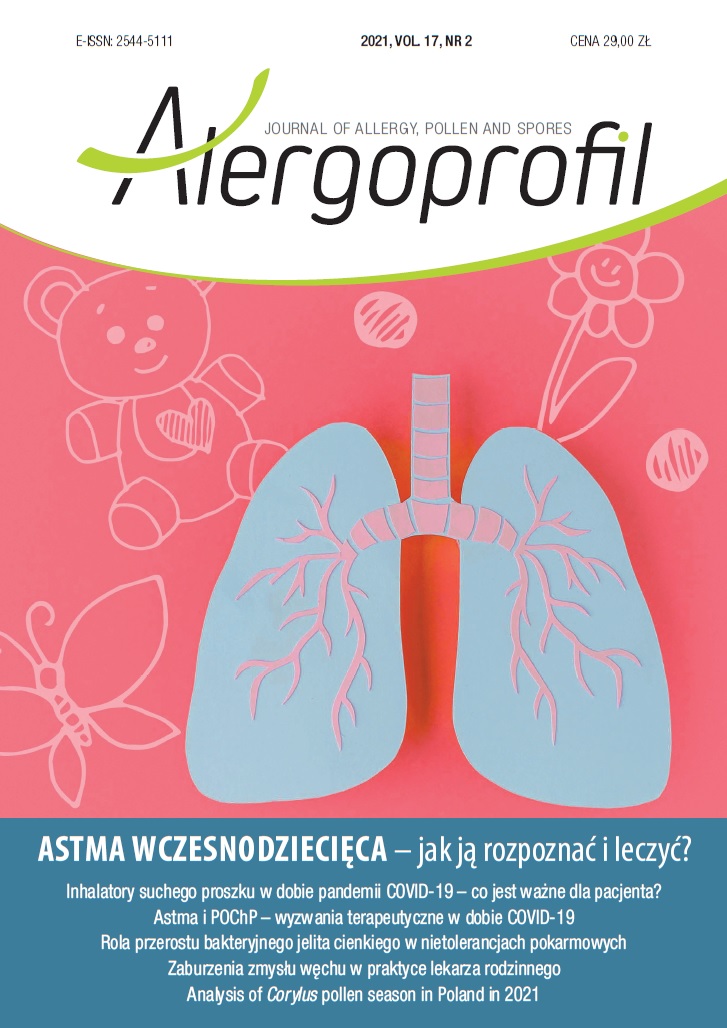Przepływy wdechowe a chmura aerozolowa z inhalatorów suchego proszku Praca przeglądowa
##plugins.themes.bootstrap3.article.main##
Abstrakt
Zależność między dawką dostarczaną, frakcją i dawką cząstek drobnych a wielkością przepływu wdechowego generowanego przez chorego jest jedną z najważniejszych cech inhalatorów suchego proszku. Wpływa ona istotnie na wielkość depozycji płucnej inhalowanego leku oraz jego efekt kliniczny. Przedstawiono wyniki badań oceniających te zależności dla popularnych w kraju inhalatorów suchego proszku. Wyróżniono inhalatory przepływowozależne, względnie przepływowozależne i względnie przepływowoniezależne.
Pobrania
##plugins.themes.bootstrap3.article.details##

Utwór dostępny jest na licencji Creative Commons Uznanie autorstwa – Użycie niekomercyjne – Bez utworów zależnych 4.0 Międzynarodowe.
Copyright: © Medical Education sp. z o.o. This is an Open Access article distributed under the terms of the Attribution-NonCommercial 4.0 International (CC BY-NC 4.0). License (https://creativecommons.org/licenses/by-nc/4.0/), allowing third parties to copy and redistribute the material in any medium or format and to remix, transform, and build upon the material, provided the original work is properly cited and states its license.
Address reprint requests to: Medical Education, Marcin Kuźma (marcin.kuzma@mededu.pl)
Bibliografia
2. Newman SP. Aerosol deposition considerations in inhalation therapy. Chest. 1985; 88: 152S-160S.
3. Emeryk A, Pirożyński M, Mazurek H et al. Polski przewodnik inhalacyjny. 2nd ed. Via Medica, Gdańsk 2021: 1-33.
4. Emeryk A, Pirożyński M, Sosnowski TR et al. Leksykon nebulizacyjny. Najczęściej spotykane i przydatne w praktyce pojęcia dotyczące nebulizacji. 1st ed. Warszawa 2018.
5. Ibrahim M, Verma R, Garcia-Contreras L. Inhalation drug delivery devices: technology update. Med Devices (Auckl). 2015; 8: 131-9.
6. Jabbal S, Poli B, Lipworth B. Does size really matter? Relationship of particle size to lung deposition and exhaled fraction. JACI. 2017; 139: 2013-5.
7. Emeryk A, Janeczek K, Emeryk-Maksymiuk J. Inhalatory suchego proszku – stare, nowe, generyczne. Terapia. 2019; 27: 68-77.
8. Levy ML, Carroll W, Izquierdo Alonso JL et al. Dry Powder Inhalers: key technical and patient preference attributes. Adv Ther. 2019; 36: 2547-57.
9. De Boer AH, Hagedoorn P, Hoppentocht M et al. Dry powder inhalation: past, present and future. Exp Opin Drug Deliv. 2017; 14: 499-512.
10. Emeryk A, Emeryk-Maksymiuk J, Janeczek K et al. Inhalatory suchego proszku w dobie pandemii COVID-19 – co jest ważne dla pacjenta? Alergoprofil. 2021 (w druku).
11. Clark AR, Hollingworth AM. The relationship between powder inhaler resistance and peak inspiratory conditions in healthy volunteers – implications for in vitro testing. J Aerosol Med. 1993; 6: 99-110.
12. Yakubu SI, Assi KH, Chrystyn H. Aerodynamic dose emission characteristics of dry powder inhalers using an Andersen Cascade Impactor with a mixing inlet: the influence of flow and volume. Int J Pharmacol. 2013; 455: 213-8.
13. Emeryk A, Bartkowiak-Emeryk M. Easyhaler na tle innych inhalatorów suchego proszku. Alergia. 2013; 2: 11-4.
14. Chrystyn H, Price D. Not all asthma inhalers are the same: factors to consider when prescribing an inhaler. Prim Care Respir J. 2009; 18: 243-9.
15. Haidl P, Heindl S, Siemon K. Inhalation device requirements for patients’ inhalation maneuvers. Respir Med. 2016; 118: 65-75.
16. The changes made (access: 1.05.2021).
17. Duexon ChPL (access: 5.05.2021).
18. Laube BL, Janssens HM, de Jongh FHC et al. What the pulmonary specialist should know about the new inhalation therapies. Eur Respir J. 2011; 37: 1308-31.
19. Berkenfeld K, Lamprecht A, McConville JT. Devices for dry powder drug delivery to the lung. AAPS Pharm Sci Tech. 2015; 16: 479-90.
20. Telko MJ, Hickey AJ. Dry powder inhaler formulation. Respir Care. 2005; 50: 1209-27.
21. Demoly P, Hagedoorn P, de Boer AH et al. The clinical relevance of dry powder inhaler performance for drug delivery. Respir Med. 2014; 108(8): 1195-203.
22. Emeryk A, Janeczek K. Inhalatory suchego proszku – najbardziej popularne inhalatory indywidualne. Alergia. 2020; 1: 11-3.
23. Pasquali I, Brambilla G, Copelli D. Effect of flow rate on dose delivery of three dry powder inhalers: NEXThaler®, Turbuhaler® and Diskus®. Respir Drug Deliv Eur. 2013: 1-6.
24. Tarsin W, Assi KH, Chrystyn H. In-vitro intra- and inter-inhaler flow rate-dependent dosage emission from a combination of budesonide and eformoterol in a dry powder inhaler. J Aerosol Med. 2004; 17: 25-32.
25. Johal B, Howald M, Fischer M et al. Fine particle profile of fluticasone propionate/formoterol fumarate versus other combination products: the DIFFUSE study. Comb Prod Ther. 2013; 3: 39-51.
26. Randomized, open label, 4-way crossover pharmacokinetic study to assess the lung deposition and the systemic safety of Budesonide/Formoterol 160 μg/4,5 μg DPI HEXAL (TEST) formulation compared to a reference formulation (REFERENCE) administered as a single dose of 640 μg/18 μg dose with and without charcoal in healthy subjects. Date from Sandoz company 2021.
27. Lavorini F, Janson Ch, Braido F et al. What to consider before prescribing inhaled medications: a pragmatic approach for evaluating the current inhaler landscape. Ther Adv Respir Dis. 2019; 13: 1753466619884532.
28. Hamilton M, Leggett R, Pang Ch et al. In vitro dosing performance of the ELLIPTA dry powder inhaler using asthma and COPD patient inhalation profiles replicated with the Electronic Lung (eLungTM). J Aerosol Med Pulm Drug Deliv. 2015; 28: 498-506.
29. Canonica GW, Arp J, Keegstra JR et al. Spiromax, a new dry powder inhaler: dose consistency under simulated real-world conditions. J Aerosol Med Pulm Drug Deliv. 2015; 28: 309-19.
30. Abadelah M, Chrystyn H, Bagherisadeghi G et al. Study of the emitted dose after two separate inhalations at different inhalation flow rates and volumes and an assessment of aerodynamic characteristics of indacaterol Onbrez Breezhaler 150 and 300 μg. AAPS PharmSciTech. 2018; 19: 251-61.
31. Emeryk A, Jedrych M, Górnicka G et al. Correlation between peak expiratory flow and selected indices of bronchial potency in children between 4 and 18 years of age. Pneumonol Alergol Pol. 1995; 63: 197-200.

